Light Therapy: Exposure To Fluorescent Light Box Can Ease Depression, Researchers Find

It’s that time of year again, when darkness hits closer to 4 p.m. than 8 p.m. and many people find themselves slumping into seasonal depression, or seasonal affective disorder (SAD). One form of relatively experimental treatment for SAD is light therapy — or indoor exposure to a fluorescent light box for several weeks. Now, researchers believe that light therapy may also be effective for regular, non-seasonal depression.
The study, published in JAMA Psychiatry, was completed by researchers at the University of British Columbia (UBC). It’s the first placebo-controlled study that finds light therapy to be an effective way to stave off ordinary, non-seasonal depression.
“These results are very exciting because light therapy is inexpensive, easy to access and use, and comes with few side effects,” Dr. Raymond Lam, a UBC professor and author of the study, said in the press release. “Patients can easily use light therapy along with other treatments such as antidepressants and psychotherapy.”
In the study, the researchers examined 122 patients who were exposed to light therapy over the course of eight weeks. The participants sat next to a fluorescent light box for 30 minutes every day, shortly after waking. A few participants were partitioned off to be the placebo group, and were given placebo pills or devices instead of the real therapy. The results showed that the non-placebo group indeed benefited from light therapy, particularly those who were also taking antidepressants.
However, past research may contradict these findings. Another recent study compared the effects of light therapy and cognitive behavioral therapy on patients suffering from SAD, and it found that simply speaking to a therapist about stress and anxieties was more effective than light therapy.
The authors of that study argue that light therapy can often be cumbersome compared to cognitive behavioral therapy. “Light therapy is a palliative treatment, like blood pressure medication, that requires you to keep using the treatment for it to be effective,” Kelly Rohan, a psychology professor at the University of Vermont, said in the press release. “Adhering to the light therapy prescription upon waking for 30 minutes to an hour every day for up to five months in dark states can be burdensome.”
Yet with one in 20 people suffering from depression, the UBC researchers believe there’s something to be said for new types of therapies. Besides, everyone is different in how they respond to treatments.
“More and more people are seeking help because there is less stigma about having depression,” Lam said in the press release. “It’s important to find new treatments because our current therapies don’t work for everyone. Our findings should help to improve the lives of people with depression.”
Source: Lam R, et al. JAMA Psychiatry. 2015.



























